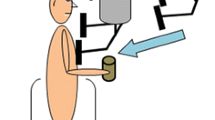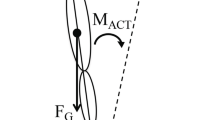Abstract
When coupling cyclic adduction–abduction movements of the arms in the transverse (horizontal) plane, isodirectional (ISO) coupling is less stable than antidirectional (ANTI) coupling. We proposed that such deficiency stems from the disturbing action that anticipatory postural adjustments exert on ISO coupling. To ascertain if postural adjustments differentiate ISO versus ANTI coupling coordination in other types of cyclic arm movements, we examined flexion–extension oscillations in the parasagittal plane. Oscillations of the right arm alone elicited cyclic Postural Adjustments (PAs) in the left Anterior Deltoid and Posterior Deltoid, which replicated the excitation–inhibition pattern of the prime movers right Anterior Deltoid, right Posterior Deltoid. Cyclic PAs also developed symmetrically in Erector Spinae (rES and lES) and in phase opposition in Ischiocruralis (rIC and lIC), so as to discharge to the ground both an anteroposterior force, Fy, and a moment about the vertical axis, Tz. Oscillations of both arms in ISO coupling induced symmetric PAs in both ES and IC muscles, thus generating a large Fy but no Tz. In ANTI coupling, PAs in rES and lES remained symmetric but smaller in size, while PAs in rIC and lIC were large and opposite in phase, resulting in a large Tz and small Fy. Altogether, PAs would thus favour ISO and hamper ANTI parasagittal movements because (1) in the motor pathways to the prime movers of either arm, a convergence would occur between the voluntary commands and the commands for PAs linked to the movement of the other arm, the two commands having the same sign (excitatory or inhibitory) during ISO and an opposite sign during ANTI; (2) the postural effort of trunk and leg muscles would be higher for generating Tz in ANTI than Fy in ISO. These predictions fit with the finding that coupling stability was lower in ANTI than in ISO, i.e., opposite to horizontal movements. In conclusion, in both parasagittal and horizontal arm movements, the less coordinated coupling mode was the one constrained by postural adjustments through the two above mechanisms.







Similar content being viewed by others

Notes
It may be argued that Fy is produced by exerting two like-parallel A-P forces on the two feet, while Tz is generated by exerting (1) antiparallel A-P forces on the two feet and, (2) isodirectional torques on each foot. By recording in 3 subjects the ground forces on each foot from two independent platforms, we could estimate that during ANTI coupling at 2.2 and 3.4 Hz, the feet torsion accounts, on average, for 43.0 ± 11.5 % of the total Tz (no significant difference between the two frequencies), so that the antiparallel A-P forces would account for 0.57 Tz. Since the lever arm (i.e., the distance between the foot midline and the CoP) was ~10 cm, the total magnitude of the A-P forces may be estimated as 0.57 Tz/b. It would thus result that at 3.4 Hz, where Fy in ISO is the largest (23.4 N), the antiparallel A-P forces in ANTI are 1.9 times larger (44.0 N) and that this ratio increases to 6.3 at 2.2 Hz, where Tz in ANTI is the largest (Fig. 5c). Assuming that the above estimate holds over all the frequency range and considering that the A-P forces provide only about half of Tz (the rest being produced by feet torsion, see above), it may be concluded that the total postural effort is always higher for generating Tz in ANTI than Fy in ISO and will therefore burden the former more than the latter coupling mode.
References
Aruin AS, Latash ML (1995) Directional specificity of postural muscles in feed-forward postural reactions during fast voluntary arm movements. Exp Brain Res 103:323–332
Aruin AS, Latash ML (1996) Anticipatory postural adjustments during self-initiated perturbations of different magnitude triggered by a standard motor action. Electroencephalogr Clin Neurophysiol 101:497–503
Baldissera F, Esposti R (2005) Postural constraints to coupling of ipsilateral hand-foot movements. NeuroReport 16:1615–1619
Baldissera F, Cavallari P, Civaschi P (1982) Preferential coupling between voluntary movements of ipsilateral limbs. Neurosci Lett 34:95–100
Baldissera F, Cavallari P, Marini G, Tassone G (1991) Differential control of in-phase and anti-phase coupling of rhythmic movements of ipsilateral hand and foot. Exp Brain Res 83:375–380
Baldissera F, Borroni P, Cavallari P (2000) Neural compensation for mechanical differences between hand and foot during coupled oscillations of the two segments. Exp Brain Res 133:165–177
Baldissera F, Borroni P, Cavallari P, Cerri G (2002) Excitability changes in human corticospinal projections to forearm muscles during voluntary movement of ipsilateral foot. J Physiol 539:903–911
Baldissera F, Rota V, Esposti R (2008a) Anticipatory postural adjustments in arm muscles associated with movements of the contralateral limb and their possible role in interlimb coordination. Exp Brain Res 185:63–74
Baldissera F, Rota V, Esposti R (2008b) Postural adjustments in arm and leg muscles associated with isodirectional and antidirectional coupling of upper limb movements in the horizontal plane. Exp Brain Res 190:289–305
Borroni P, Cerri G, Baldissera F (2004) Excitability changes in resting forearm muscles during voluntary foot movements depend on hand position: a neural substrate for hand-foot isodirectional coupling. Brain Res 1022:117–125
Bouisset S, Do MC (2008) Posture, dynamic stability, and voluntary movement. Neurophysiol Clin 38:345–362
Bouisset S, Zattara M (1987) Biomechanical study of the programming of anticipatory postural adjustments associated with voluntary movement. J Biomech 20:735–742
Byblow WD, Coxon JP, Stinear CM, Fleming MK, Williams G, Muller JF, Ziemann U (2007) Functional connectivity between secondary and primary motor areas underlying hand-foot coordination. J Neurophysiol 98:414–422
Carson RG (1993) Manual asymmetries: old problems and new directions. Hum Mov Sci 12:479–506
Carson RG, Goodman D, Kelso JA, Elliott D (1995) Phase transitions and critical fluctuations in rhythmic coordination of ipsilateral hand and foot. J Mot Behav 27:211–224
Carson RG, Smethurst CJ, Forner M, Meichenbaum DP, Mackey DC (2002) Role of peripheral afference during acquisition of a complex coordination task. Exp Brain Res 144:496–505
Cerri G, Borroni P, Baldissera F (2003) Cyclic H-reflex modulation in resting forearm related to contractions of foot movers, not to foot movement. J Neurophysiol 90:81–88
Cordo PJ, Nashner LM (1982) Properties of postural adjustments associated with rapid arm movements. J Neurophysiol 47:287–302
Esposti R, Baldissera FG (2013) The role of anticipatory postural adjustments (APAs) in interlimb coordination of coupled arm movements in the parasagittal plane: I. APAs associated with fast discrete flexion and extension movements of one arm or of both arms ISO- and ANTI-directionally coupled. Exp Brain Res. doi:10.1007/s00221-013-3584-3
Esposti R, Esposito F, Ce E, Baldissera F (2010) Difference in the metabolic cost of postural actions during iso- and antidirectional coupled oscillations of the upper limbs in the horizontal plane. Eur J Appl Physiol 108:93–104
Hodges P, Cresswell A, Thorstensson A (1999) Preparatory trunk motion accompanies rapid upper limb movement. Exp Brain Res 124:69–79
Hodges PW, Cresswell AG, Daggfeldt K, Thorstensson A (2000) Three dimensional preparatory trunk motion precedes asymmetrical upper limb movement. Gait Posture 11:92–101
Jeka JJ, Kelso JA (1995) Manipulating symmetry in the coordination dynamics of human movement. J Exp Psychol Hum Percept Perform 21:360–374
Kelso JA (1984) Phase transitions and critical behavior in human bimanual coordination. Am J Physiol 246:R1000–R1004
Kelso JA, Jeka JJ (1992) Symmetry breaking dynamics of human multilimb coordination. J Exp Psychol Hum Percept Perform 18:645–668
Lee LJ, Coppieters MW, Hodges PW (2009) Anticipatory postural adjustments to arm movement reveal complex control of paraspinal muscles in the thorax. J Electromyogr Kinesiol 19:46–54
Leonard JA, Gritsenko V, Ouckama R, Stapley PJ (2011) Postural adjustments for online corrections of arm movements in standing humans. J Neurophysiol 105:2375–2388
Marsden CD, Merton PA, Morton HB (1981) Human postural responses. Brain 104:513–534
Massion J (1992) Movement, posture and equilibrium: interaction and coordination. Prog Neurobiol 38:35–56
Schepens B, Drew T (2004) Independent and convergent signals from the pontomedullary reticular formation contribute to the control of posture and movement during reaching in the cat. J Neurophysiol 92(4):2217–2238
Schepens B, Drew T (2006) Descending signals from the pontomedullary reticular formation are bilateral, asymmetric, and gated during reaching movements in the cat. J Neurophysiol 96(5):2229–2252
Schepens B, Stapley P, Drew T (2008) Neurons in the pontomedullary reticular formation signal posture and movement both as an integrated behavior and independently. J Neurophysiol 100(4):2235–2253
Schoner G, Haken H, Kelso JA (1986) A stochastic theory of phase transitions in human hand movement. Biol Cybern 53:247–257
Serrien DJ, Swinnen SP (1998) Load compensation during homologous and non-homologous coordination. Exp Brain Res 121:223–229
Shiratori T, Aruin AS (2004) Anticipatory postural adjustments associated with rotational perturbations while standing on fixed and free-rotating supports. Clin Neurophysiol 115:797–806
Shiratori T, Aruin A (2007) Modulation of anticipatory postural adjustments associated with unloading perturbation: effect of characteristics of a motor action. Exp Brain Res 178:206–215
Sparrow WA, Lay BS, O’Dwyer NJ (2007) Metabolic and attentional energy costs of interlimb coordination. J Mot Behav 39:259–275
Strang AJ, Berg WP (2007) Fatigue-induced adaptive changes of anticipatory postural adjustments. Exp Brain Res 178:49–61
Swinnen SP (2002) Intermanual coordination: from behavioural principles to neural-network interactions. Nat Rev Neurosci 3:348–359
van der Woude LH, Horstman A, Faas P, Mechielsen S, Bafghi HA, de Koning JJ (2008) Power output and metabolic cost of synchronous and asynchronous submaximal and peak level hand cycling on a motor driven treadmill in able-bodied male subjects. Med Eng Phys 30:574–580
Zattara M, Bouisset S (1988) Posturo-kinetic organisation during the early phase of voluntary upper limb movement. 1. Normal subjects. J Neurol Neurosurg Psychiatry 51:956–965
Acknowledgments
This study was supported by a PUR grant from the Università degli Studi di Milano
Author information
Authors and Affiliations
Corresponding author
Rights and permissions
About this article
Cite this article
Baldissera, F.G., Esposti, R. The role of anticipatory postural adjustments in interlimb coordination of coupled arm movements in the parasagittal plane: II. Postural activities and coupling coordination during cyclic flexion–extension arm movements, ISO- and ANTI-directionally coupled. Exp Brain Res 229, 203–219 (2013). https://doi.org/10.1007/s00221-013-3605-2
Received:
Accepted:
Published:
Issue Date:
DOI: https://doi.org/10.1007/s00221-013-3605-2



